
Tillamook Bay is a small inlet of the Pacific Ocean, approximately 6 mi (10 km) long and 2 mi (3 km) wide, on the northwest coast of the U.S. state of Oregon. It is located just north of Cape Meares in western Tillamook County approximately 75 mi (120 km) west of Portland.
The Surfman Badge is a military badge of the United States Coast Guard, issued to enlisted or officer personnel who qualify as Coxswains authorized to operate surf boats in heavy surf. Surf boats are boats that are designed to operate under extreme weather and sea conditions. Some surf boats that the Coast Guard operates are the 47-foot Motor Lifeboat (MLB), the 44-foot MLB, 42-foot Near Shore Lifeboat (SPC-NLB) and the 52-foot MLB such as Victory at Station Yaquina Bay, Oregon, the oldest steel motor lifeboat in the US Coast Guard.
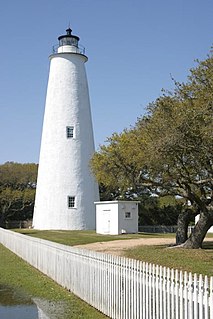
OcracokeLight was built in Hyde County, on Ocracoke Island, North Carolina in 1823 by Massachusetts builder Noah Porter. The lighthouse stands 75 feet (23 m) tall. Its diameter narrows from 25 feet (7.6 m) at the base to 12 feet (3.7 m) at its peak. The lighthouse was built to help guide ships through Ocracoke Inlet into Pamlico Sound.

The United States Life-Saving Service was a United States government agency that grew out of private and local humanitarian efforts to save the lives of shipwrecked mariners and passengers. It began in 1848 and ultimately merged with the Revenue Cutter Service to form the United States Coast Guard in 1915.

The Houses of Refuge in Florida were a series of stations operated by the United States Life-Saving Service along the coast of Florida to rescue and shelter ship-wrecked sailors. Five houses were constructed on the east coast in 1876, with five more added in 1885. There were also two life-saving stations built, one just south of the Jupiter Inlet, the other on the Gulf coast on Santa Rosa Island near Pensacola, Florida. A house of refuge was planned for the Marquesas Keys, but was never put into commission. The houses were manned by civilian contractors who lived in the houses with their families. Most of these houses remained in service as life-saving stations until 1915 or later. Some of the locations became United States Coast Guard stations after the Life Saving Service was merged into the Coast Guard in 1915.

The Virginia Beach Surf & Rescue Museum honors and preserves the history of Virginia's maritime heritage, coastal communities, the United States Lifesaving Service, and the United States Coast Guard along the Atlantic coast.

Joshua James was an American sea captain and a U.S. Lifesaving Station keeper. He was a famous and celebrated commander of civilian life-saving crews in the 19th century, credited with saving over 500 lives from the age of about 15 when he first associated himself with the Massachusetts Humane Society until his death at the age of 75 while on duty with the United States Life-Saving Service. During his lifetime he was honored with the highest medals of the Humane Society and the United States. His father, mother, brothers, wife, and son were also lifesavers in their own right.

Pea Island Life-Saving Station was a life-saving station on Pea Island, on the Outer Banks of North Carolina. It was the first life-saving station in the country to have an all-black crew, and it was the first in the nation to have a black man, Richard Etheridge, as commanding officer. On August 3, 2012, the second of the Coast Guard's 154-foot Sentinel-Class Cutters, USCGC Richard Etheridge (WPC-1102), was commissioned in his honor.
A rescue lifeboat is a boat rescue craft which is used to attend a vessel in distress, or its survivors, to rescue crew and passengers. It can be hand pulled, sail powered or powered by an engine. Lifeboats may be rigid, inflatable or rigid-inflatable combination hulled vessels.
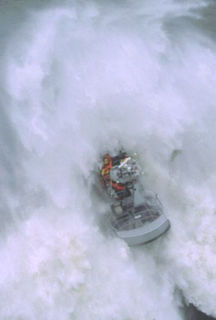
United States Coast Guard Station Cape Disappointment, situated near Cape Disappointment, Washington, at the mouth of the Columbia River, is the largest United States Coast Guard search and rescue station on the Northwest Coast, with 50 crewmembers assigned. Cape Disappointment Station is also the site of the oldest search and rescue station within the Thirteenth Coast Guard District. The station's Area of Responsibility reaches from Ocean Park on the Washington Coast south to Tillamook Head on the Oregon Coast.

United States Coast Guard Station Manomet Point was a United States Life-Saving Service station – and later a United States Coast Guard station – located on Manomet Point in Manomet, Massachusetts. The station was a sub-unit of Sector Southeast New England.
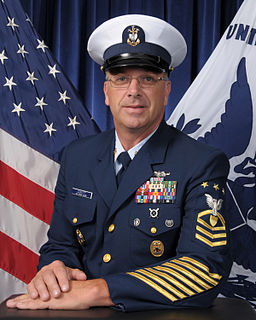
Michael Phillip Leavitt was the eleventh Master Chief Petty Officer of the Coast Guard (MCPOCG). He assumed the position from MCPOCG Charles W. Bowen on May 21, 2010 and was relieved on May 22, 2014 by Steven W. Cantrell. Leavitt was previously serving as the Senior Enlisted Advisor to the Deputy Commandant for Operations at Coast Guard Headquarters, Washington, DC.

The 30 foot surf rescue boat is a lifeboat that the United States Coast Guard has used in recent years. The 30' long boat is designated the surf rescue boat (SRB) and was introduced in 1983.
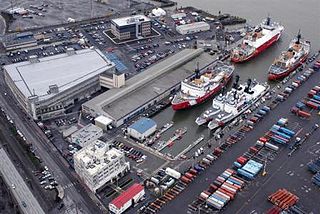
District 13 is a United States Coast Guard district, based at the Henry M. Jackson Federal Building, in Seattle, Washington. It covers the Pacific Northwest and its Area of Responsibility encompasses four states; Washington, Oregon, Idaho, and Montana. District 13 is divided into three Sectors – Puget Sound, Columbia River and North Bend. The District has more than 3,000 active duty and reserve members, civilian employees, and auxiliaries and operates twenty-one cutters, 132 boats and eleven aircraft.

The Humboldt Bay Life-Saving Station was originally built in November 1878 on the north side of the entrance to Humboldt Bay in northern California, United States near Eureka, adjacent to the site of the first Humboldt Harbor Light (1856–1892). Rebuilt in 1936 with marine railways to launch rescue surfboats, the historic facility was placed on the National Register of Historic Places on October 30, 1979. The station continues to function as an important asset of the United States Coast Guard in the Coast Guard Group/Air Station Humboldt Bay.
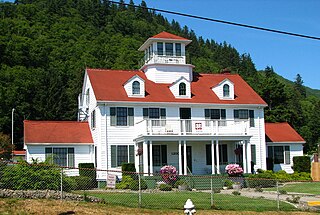
Coast Guard Station Tillamook Bay is an active duty installation of the United States Coast Guard located in Garibaldi, Oregon, as well as a nationally recognized historic site. A station has been operating in Tillamook Bay since 1908. The station was opened by the United States Life-saving Service a precursor agency to the Coast Guard. The current station has been in continuous operation since 1942.

Coast Guard Station Oak Island referred to locally as the Oak Island Coast Guard Station (OIGCS) is located in the Town of Caswell Beach on Oak Island in Brunswick County, North Carolina. A part of the Cape Fear region, the station is in the United States Coast Guard 5th District which is charged with ensuring the safety and security of the oceans, coastal areas, and marine transportation system within the Mid-Atlantic Region. The district encompasses some 156,000 square miles of ocean, bays, rivers, wetlands and tidal marshes, geographic waterways, several major mid-Atlantic ports, and the Nation’s capital.

U.S. Coast Guard Station Golden Gate is a U.S. Coast Guard station in Sausalito, California. It falls under Coast Guard Sector San Francisco in the U.S.C.G.'s District Eleven.

John F. McCormick was a sailor in the United States Coast Guard who was recognized for his courage. McCormick was born in Portland, Oregon, and served much of his 26 year Coast Guard career in Oregon. After his 1947 retirement he made his home in Garibaldi, Oregon, where he lived another 39 years.


























